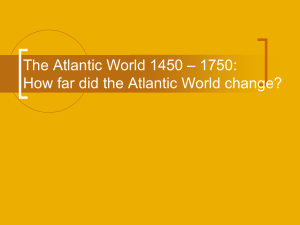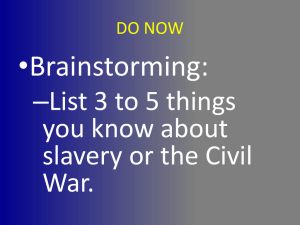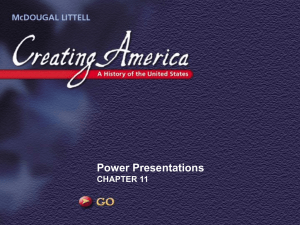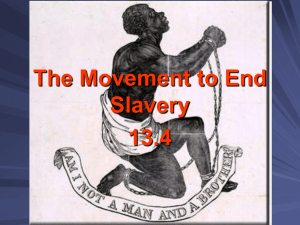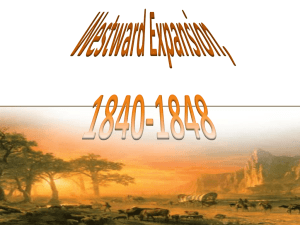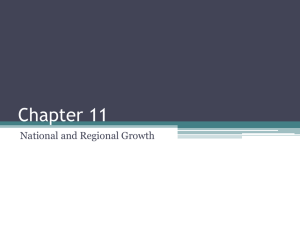Chapter 9: Jacksonian Era
advertisement
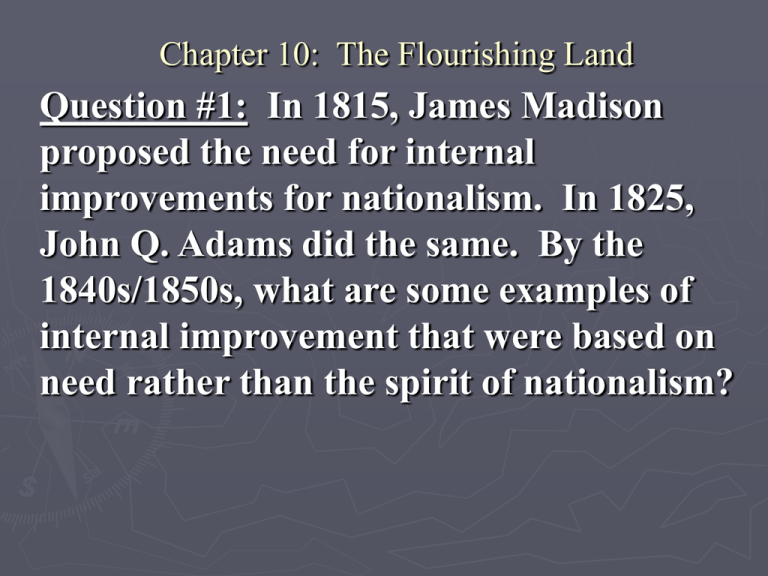
Chapter 10: The Flourishing Land Question #1: In 1815, James Madison proposed the need for internal improvements for nationalism. In 1825, John Q. Adams did the same. By the 1840s/1850s, what are some examples of internal improvement that were based on need rather than the spirit of nationalism? Chapter 10: The Flourishing Land Chapter 10: The Flourishing Land 1840s and 1850s – The United States continued to grow! •Despite Sectionalism (Union v. States Rights) •Despite Financial Ruin (Andrew Jackson v. Monster) How was it growing? •Transportation – Turnpikes and Roads, Canals and Railroads, Steamboats and Locomotives. •Communication – Est. of Post Office and Post Roads, Samuel Morse and the invention of the telegraph and Morse Code. •Industrial Revolution – Imported from England, will help develop the Transportation Revolution •Immigration – America's #1 Import •Slavery – Cotton becomes King Chapter 10: The Flourishing Land Empire for Liberty - It was becoming more of a necessity to come up with new technologies to keep America connected. •Use of Turnpike and actual paved roads to travel on. •Using canals for industry, trade, and travel. (Steamboats) But it was the Railroad Industry and the use of the locomotive engine that will connect the people and business of the East to the West! by private companies. (RR – From nowhere, to nowhere) •Labor intensive. (Need $$$ for laborers – pay, food, shelter) •Building from scratch – (Industry built literally from ground up.) •Major capital investment by the Federal Government •Built Chapter 10: The Flourishing Land • The Constitution called for the “establishment of the Post Office and post roads.” – Roads, Canals, Railroads • Postmaster General: Hired mile carriers and created cheap postage to pay for the post roads and carriers. • Samuel Morse – Invents the telegraph and Morse Code • Used electricity to send messages across wires from town to town. Dot and Dashes! Chapter 10: The Flourishing Land Chapter 10: The Flourishing Land The Industrial Revolution – 1st in Britain. Wanted Monopoly • • • on IR. It took a “spy” to bring it to the United States. Samuel Slater memorized the design of the machinery and opened the 1st American textile mill in 1792. The IR Transportation Revolution b/c steam would power industry and transportation. (Transportation was used to deliver the product made in the factories.) Moving from Agrarian to Industry b/c of supply and demand. • To move food to N and E, the W and S relied heavily on products manufactured in N and E. Remember we are a land untapped resources, unlimited land, and an industrious and enterprising workforce, made America a stronger country. Chapter 10: The Flourishing Land • How did the IR catch on in America so quickly, when England and Europe are closer to each other? • Answer: The limits of national borders and jealous governments halted the free flow of goods and people in European countries. No here, the Founding Fathers envisioned the need to let people and goods flow freely from state to state, and back and forth across the whole country. • Chapter 10: The Flourishing Land Industrial Revolution created a new Social Invention “Joint Stock Company” • Shares of stock were sold to numerous investors who now had a “share” in the ownership in the company. Either made or lost money. Corporation – “JSC” chartered by a state. • It had a life of its own and would survive in legal theory even if the shareholders died. Acted like a person! “Limited Liability” • stock holder could not be held liable for company debts. Chapter 10: The Flourishing Land American IR differs from British IR • “Waltham” Factory – Francis Cabot Lowell • Use water instead of steam – less pollution • Use women and children – actually pay them and resolve the shortage of labor in cities. • Eli Whitney – Cotton Gin Inventor and Gunsmith • “Uniformity System” or “Interchangeable System” • Making precise copies of the same part for each individual product, so that in the field that same part could be taken from one product and placed in another product Chapter 10: The Flourishing Land • Mass Production – producing masses of items of exactly the same kind. • Cheaper • Affordable • Creates opportunity • More demand required the need to provide more expensive and more advanced supply. • Each worker’s time was important, because he could produce more of any product in a single day. • Employer could pay employee more money and still make a profit. New American Standard of Living – The World is Jealous Chapter 10: The Flourishing Land • America’s Leading Import – People • Immigrate – To come a country of which one is not a native, usually for permanent residence. • People from around the world came to America to occupy the land, Build roads, canals, railroads, and to fill the factories. • Were here to work, because that was the only lifestyle they knew. This is a benefit for those intuitive Americans building on the Industrial Revolution. • Why did they leave? • Overcrowding, No food, No education (learn a job skill), Too much War (death), and Bad Weather • America offered open air, cheap land and Hope. Chapter 10: The Flourishing Land • The Great Migration included the Irish, Germans, Scandinavians, Dutch, Belgians, French, and Italians. • Just like “steam”, immigrants will power the Industrial Revolution, and boom in communication and transportation. • They are the ones that dug the ditches for canals, cleared the forests for road and rail roads, and manned the production lines of industry. • They also brought with them their own innovations to make America stronger. Chapter 10: The Flourishing Land • Southerners feared Internal Improvements • When the Fed Gov’t started funding federal projects: • Fed Gov’t would start interfering w/ slavery. • Abolitionists (wanted to abolish slavery from America) – Educating the North about slavery • Southerners would defend their way of life – Slavery • “Necessary Evil” “Slavery is not evil, it is a national benefit.” • Slave owners – “protect the weak from those trying to oppress them. Chapter 10: The Flourishing Land • Slaves were forced to come to America. • Most immigrants came to America on their own free will – Great Migration • Middle Passage – Slaves were caught, put in chains and placed on cargo ships and send to America • A horrendous voyage where Africans were packed tightly together and chained below the decks of cargo ships. • If they survived the voyage, they were sold at auction in the Americas, Brazil, United States, or the West Indies. • The Slave Trade was legally abolished in 1807. • Slaves were smuggled to America • Domestic slave trade will flourish until the Civil War. Chapter 10: The Flourishing Land • Why did the South still feel that it was necessary to continue to bring more Africans into America to fuel their Economy? Open Land – Opportunity out west to expand the Southern Economy, before Industry beat them too it 2. Slavery tied to Southern way of life. 3. “King” of all Crops – Cotton • Cotton being used in most textile mills, i.e. clothing. The British were “nuts’ for Cotton (Europe was too.) • British demand for Cotton would keep slavery alive and keep Cotton “King.” • Affect of Slavery on the South – Slavery blocked the economic development in the South & helped divide the South from the Nation. 1.


